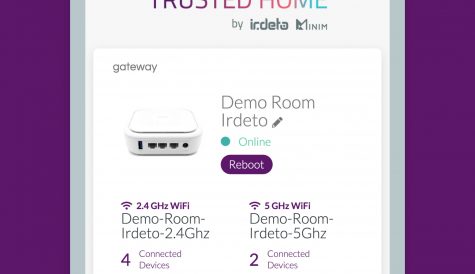
After more than 40 years of operation, DTVE is closing its doors and our website will no longer be updated daily. Thank you for all of your support.
WISI focuses on next-generation networks
WISI will use this year’s IBC to unveil various optimised solutions for the extension and operation of next generation networks.
 Highlights are the Inca ABR Transcoder 3840 along with new features for Tangram and Chameleon and the extended Optupus platform.
Highlights are the Inca ABR Transcoder 3840 along with new features for Tangram and Chameleon and the extended Optupus platform.
WISI claims that the Inca ABR Transcoder 3840 sets new standards for performance and density while the company has extended feature sets for two internationally-deployed headend systems, Chameleon and Tangream. With these products, network operators can optimise their existing transmitting and distribution infrastructures while enjoying key competitive advantages, according to the company.
WISI says that the Inca ABR Transcoder 3840 is optimised for multiscreen and OTT applications and can transcode up to 24 HD or 48 SD channels to multi-bitrate profiles. It has a high density and can process a large number of TV channels in a single rack unit for OTT delivery.
WISI says it has also improved the flexibility and security of investment for the operator. The high density of the transcoder is maintained even when source codecs, bitrates or formats are changed by the content owner, which helps operators plan OTT projects with confidence, e.g. from MPEG-2 to MPEG-4, or from 1080i with 30 frames per second to 720p with 60 frames per second or from SPTS to MPTS.
Finall the ABR Transcoder 3840 features low energy consumption and low operational costs making it the perfect solution to launch new multiscreen services.
WISI has integrated into its multi-headend platform Chameleon the All Seeing Eye (ASE) monitoring and troubleshooting tool. This multi-view monitoring platform features a visual mosaic of video thumbnails and gives operators greater visibility and reliability within their network. The faster detection and troubleshooting of errors in the transmitting of TV channels and streams allows to the operator to reduce outages significantly and increase customer satisfaction while also lowering operational costs, according to WISI.
WISI has also optimised the encoding capabilities of Chameleon. Thanks to higher density, the costs for encryption per TV channel have decreased, the company claims. This is important for network operators and content providers supplying TV channels and video streams to the hospitality industry that need to protect and encode content.
Chameleon now supports the new standard for broadcasting via satellite (DVB-S2X) and offers additional features such as traffic shaping and real-time transport stream monitoring.
WISI has also integrated support for the visual monitoring platform, All Seeing Eye into its high-density platform Tangram. Operators now profit from more efficient channel encoding options provided by new software licenses for Pro:Idiom and Samsung LYNK. Finally, Tangram also supports the satellite broadcasting standard DVB-S2X.
The optical platform Optopus has been extended by WISI towards CCAP and DOCSIS 3.1. Optopus is a high-density platform for all kinds of RF optical networks. The system may be used in any network, such as HFC, RF over Glass and RF Overlay in FTTx applications.
The inverted node LR 44 provides FTTH access through existing HFC plants. The integrated components allow the smallest footprint for OBI-free RFoG deployments including optical
amplification and high splitting ratios to connect up to 32 ports with options for further internal splits. This is enabled by ruggedised housing that supports installation in harsh environments.
LR 44 is compliant with the DOCSIS 3.1 specification with 1.2 GHz in downstream and up to 204 MHz in upstream direction via a pluggable diplexer.
WISI’s ASC/ALSC module VX58B supports automated initial operation via its auto alignment functionality. Here the desired system level and the system slope are adjusted automatically to achieve an optimal control reaction of the amplifier, according to WISI. The main reason for the level variation at the input is the temperature dependent frequency response of the coaxial cable. It controls a constant output level independent from the input level within the control range.
For Remote-PHY deployments, the Dual DVB-C Analyzer VT45 for the end-to-end monitoring of signal quality has an integrated Dual DVB-C tuner for the continuous monitoring of the complete broadcast spectrum and the simultaneous detailed monitoring of a single channel on basis of the TS 101290 Prio1 KPIs. This allows the extended management of the remote PHY nodes by the DVB-C parameters. In addition to VT45 the DOCSIS transponder VT 52 D and the HMS transponder VT 52 B still exist. With these add-on modules DOCSIS 3.1 nodes and amplifiers in the WISI portfolio can be extended by further control and monitoring capabilities.
WISI will be exhibiting at IBC on stand 5.B90


